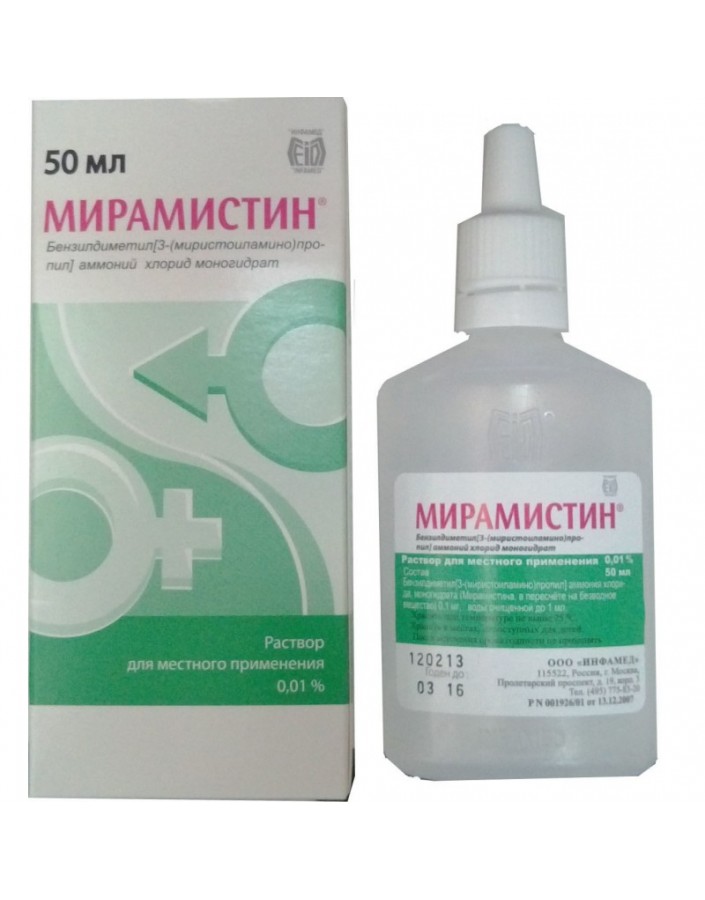




Security policy (edit with Customer reassurance module)

Delivery policy (edit with Customer reassurance module)

Return policy (edit with Customer reassurance module)
Solution for local use 0.01%:
1 ml of solution contains Miramistin 0.1 mg;
in polyethylene bottles with urethral nozzle 50, 100 ml or
in polyethylene bottles of 200 ml, equipped with a spray pump; in the box 1 bottle, or
in polyethylene bottles of 500 ml.
Ointment 0.5%: 1 g of ointment contains Miramistina 5 mg;
in aluminum tubes of 15 g; in a pack of cardboard 1 tube.
solution: №001926/01-2002, 29.11.2002
ointment: №013144/01-2001, 06.07.2001
Antiseptic drug. The mechanism of action is associated with the hydrophobic interaction of the drug with the cytoplasmic membranes of microorganisms, which leads to their destruction. Bactericidal effect. Miramistin is active against gram-positive and gram-negative, aerobic and anaerobic, spore-forming and asporogenic bacteria in the form of monocultures and microbial associations, including hospital strains with multi-resistance to antibiotics. Gram-positive microorganisms (Staphylococcus spp., Streptococcus spp., Bac. Anthracoides, Bac. Subtilis) have the highest sensitivity to the drug; mushrooms (Candida albicans, Candida tropicalis, Trichophyton rubrum, Microsporum lanosum, Aspergillus niger); Gram-negative microorganisms: Neisseria spp., Eschrichia spp., Shigella spp. (including Sonne, Flexner), Salmonella spp. (typhoid, paratyphoid A and B, causative agents of food toxicoinfections), Vibrio spp. (including cholera, NAG, paracholeric, para hemolytic), Treponema pallidum, Corynebacterium diphtheriae; protozoa (Chlamidium trachomatis, Chlamidium pneumonia). Miramistin also has an antiviral effect.
Solution for local use:
- prevention of suppuration and treatment of purulent wounds in surgical and obstetric practice;
- superficial and deep burns;
- inflammatory diseases of the female genital sphere;
- individual prevention of sexually transmitted diseases (syphilis, gonorrhea, trichomoniasis, chlamydia, genital herpes, genital candidiasis);
- acute and chronic urethritis and urethroprostatitis of a specific and non-specific nature;
- periodontitis, stomatitis, hygienic processing of removable dentures;
- acute and chronic otitis media, sinusitis, tonsillitis, laryngitis (as part of complex therapy).
Ointment:
- treatment of infected wounds and prevention of infectious complications in surgical practice;
- superficial and deep burns, frostbite;
- strepto-and staphyloderma;
- candidiasis of the skin and mucous membranes;
- mycoses of the feet and large skin folds (including dishydrotic and complicated by pyoderma), onychomycosis, keratomycosis, pityriasis versicolor.
Solution for local use:
In the treatment of purulent wounds and burns prescribe the imposition of gauze dressings moistened with a solution of the drug.
In the treatment of acute and chronic urethritis and urethroprostatitis prescribed in combination with other drugs. The solution is injected into the urethra in a volume of 2-5 ml 2-3 times / day for 5-7 days.
For the prevention of postpartum injury infections tampons soaked in 50 ml of a solution with an exposure of 2 hours for 7 days are administered intravaginally.
For the prevention of sexually transmitted diseases injected into the urethra to men - 1.5-3 ml, for women -1-1.5 ml; in the vagina - 5-10 ml for 2-3 minutes; process external genital organs, the skin of the pubis.
Ointment
Locally. Ointment is applied directly to the affected surface under a sterile gauze bandage or loosely tampon wounds and fistulous passages with tampons soaked in ointment. The duration of treatment is set individually.
Local reactions: rarely - a burning sensation at the site of application (runs independently within 10-15 seconds and does not require discontinuation of the drug).
Hypersensitivity to the drug.
Perhaps the appointment of Miramistin during periods of pregnancy and lactation according to indications, since when applied topically and locally, systemic absorption of the active substance is unlikely.
AT experimental studies teratogenic and embryotoxic effect of the drug was not detected.
AT experimental studies mutagenic effect of the drug was not detected.
Currently, cases of drug overdose Miramistin were reported.
With simultaneous use of the drug Miramistin with antibiotics, a decrease in the resistance of microorganisms to the latter was noted.
Solution: at room temperature;
ointment: in a dry place, at a temperature of 8–15 ° C
Miramistin 001%